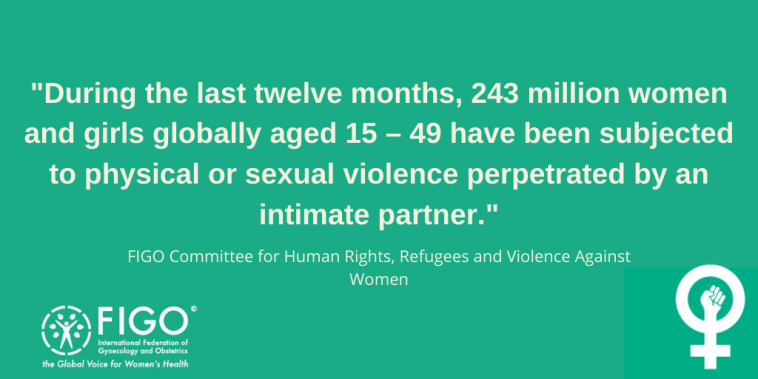Gender Based Violence In The COVID-19 Pandemic

On the 27th August 2020, we held a webinar on women’s SRHR during COVID-19. Below is part one of the summary of the points raised and topics discussed during the webinar, written by our Human Rights, Refugees and Violence Against Women Committee. Topics covered include the impact of the pandemic on gender-based violence, as told by Prof. Rubina Sohail, and a discussion on the impact of the virus on SRHR from Dr Margit Endler.
Gender Based Violence In The COVID-19 Pandemic
Prof. Rubina Sohail, FCPS, FRCOG, Chair FIGO Subcommittee for Violence against Women
Globally 1 in 3 women experience physical or sexual violence in their lifetime, with intimate partner violence being the most common. Violence increases during all emergencies, and older women, women with disabilities and poor women are at increased risk. Displaced women, refugees and women living in conflict areas are particularly vulnerable. Gender-based violence results in serious physical, mental, sexual and reproductive health issues including STDs, HIV, and unplanned pregnancy
Impact on GBV in Pakistan – A True Story
I would like to share a story about a Pakistani woman, Mrs. SS, who was the primary earner of the household. For 3 years she ran a successful embroidery business. Her business boasted nine male employees, each earning PKR 40,000/month. Out of the profits, Mrs. SS paid for her kids’ school fees and other life utilities, until, COVID-19 hit, wiping out the demand for her products. She lost her business, became a stay-at-home mother living with an abusive husband and continued to suffer from this abuse. For this woman, and many others sheltering at home with their abusers, life is increasingly precarious.
COVID-19 exacerbates violence risk for women - 'The Already Vulnerable Become More Vulnerable'
COVID-19 increases the risk of GBV for women as many of them now have to stay at home. Job losses mean greater economic burden, resulting in economic abuse of women. School closures worsen the burden for women. Contact with family and friends, and social and protective networks breaks down. Social distancing adds to the stress.
During the last twelve months, 243 million women and girls globally aged 15 – 49 have been subjected to physical or sexual violence perpetrated by an intimate partner. This number is likely to increase as health, security and money concerns heighten tensions in an already compromised environment. Emerging data shows that since the outbreak of COVID 19, gender-based violence, especially domestic violence has intensified.
There has been a 30% increase in domestic violence in France, Cyprus and Singapore and 25% increase in Argentina. Domestic violence has tripled in Jingzhou in February 2020. According to extrapolated figures, crimes against women and children in Pakistan increased 200% in March from February 2020.
The challenges in dealing with this situation are two-fold: firstly, only 40% women and girls report violence, and secondly, the financial burden of managing the increased case-load is huge. It is estimated that the global cost of violence against women is $1.5 trillion. The surge in COVID-19 cases is straining even the most advanced health systems.
There are three questions to be answered – What needs to be done? Who will do it? How will it be done?
What Needs to be Done?
We need to create awareness at all levels including the public, health care workers, policy makers and the justice department, including the police.
Who Will Do It?
Communities, neighbours, health workers including community workers, frontline providers, health managers, police departments and governments. In addition, the professional societies and international organisations have to join hands with the government.
How Will It Be Done?
The response requires multiple strategies and policies, including standard operating procedures for managing GBV, check lists and guidelines. The media should be used to create awareness and deliver health messages. The use of technologies as telemedicine, help lines and mobile apps can be put to use. Integrated health service packages including rehabilitation services and mental health support should be introduced.
Impact of Covid-19 on SRHR: Outcomes of HRRVW survey
Margit Endler, MD, PhD
A multi-methods global survey presented in the webinar shows that many countries have seen decreased access to, and increased violations of SRHR during the COVID-19 pandemic. Countries that had pre-existing severe restrictions on abortion seemed less likely to have mitigated this impact by facilitating access to abortion and contraception, than countries with more liberal policies.
This indicates that the COVID-19 pandemic has most severely impacted women who already suffer from lack of access to SRHR services. Political will to support the advancement of SRHR is often lacking, and this is fundamental to ensuring both continued access during the pandemic and, in a minority of cases, the solidification of gains made in SRHR made during the crisis.
References (For parts 1 & 2)
Koblinsky M, Moyer C, Calvert C, Campbell J, Campbell O, Feigl A, Graham W, Hatt L, Hodgins S, Matthews Z, McDougall L, Moran A, Nandakumar A & Langer A. Quality maternity care for every woman, everywhere: a call to action. Lancet Maternal Health series. 2016
Bateson DJ, Lohr PA, Norman WV, Moreau C, Gemzell-Danielsson K, Blumenthal PD, Hoggart L, Li HR, Aiken ARA, Black KI. The impact of COVID-19 on contraception and abortion care policy and practice: experiences from selected countries.BMJ Sex Reprod Health. 2020 Aug 11:bmjsrh-2020-200709. doi: 10.1136/bmjsrh-2020-200709
Cousins S. Lancet 2020;396:301-2
Gomperts RJ, Jelinska K, Davies S, Gemzell-Danielsson K, Kleiverda G.
Using telemedicine for termination of pregnancy with mifepristone and misoprostol in settings where there is no access to safe services.
BJOG. 2008 Aug;115(9):1171-5;
Endler M, Lavelanet A, Cleeve A, Ganatra B, Gomperts R, Gemzell-Danielsson K. Telemedicine for medical abortion: a systematic review. BJOG. 2019